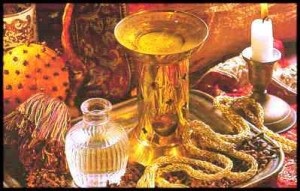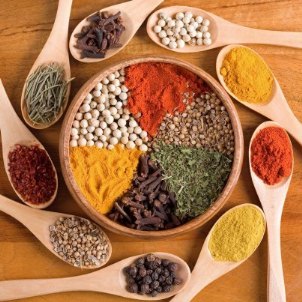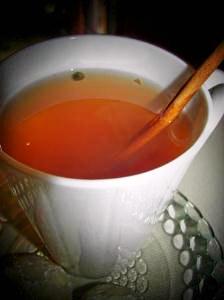“And somewhere near India is the island containing the Valley of the Cloves.
No merchants or sailors have ever been to the valley or have seen the kind of tree that produces cloves:
its fruit, they say, is sold by genies . . . the islanders feed on them, and they never fall ill or grow old.”
– Summary of Marvels (Ibrahim ibn Wasif-Shah, ca. 1000 CE)
From Indonesia’s Moluccas (Maluku) Islands to the rest of the world come the tiny but powerful flowerbuds we know as cloves. More accurately, cloves are flowerbuds from the Syzygium aromaticum tree that are picked before opening and dried in the sun until they resemble the little reddish-brown batons used in most of the world’s cuisines. Mentioned in the Indian Ramayana by the 5th or 4th century BCE (but possibly as early as the 10th Century BCE) and in later Chinese texts by about the 3rd century BCE, these little blasts of bittersweet peppery flavor that we know today for their ability to energize other spices was first used for its aroma and as a medicinal ingredient.*

Additional medicinal uses in China and India included chewing cloves as a dental anesthetic or using an external rub of clove oil as a general analgesic or to lessen the pain of rheumatism.
It is unclear when cloves started to be used as a culinary spice. It is used in modern five-spice powders and garam-masalas, but there is little but unreferenced and contradictory information about the antiquity of its use in these culinary mixtures. In the west, by the time of Pliny the Elder, the clove was still used as an aromatic perfume (NH 12.15), and there is also no mention of the culinary use of cloves in the 4th century ACE Cooking and Dining in Imperial Rome. In the 6th and 7th century Byzantine writings of Kosmas Indicopleustes and Paulus Aegineta, cloves are still used for their scent and clove oil used topically as medicine.
There are intermediate uses of cloves as both medicine and culinary spice in 9th Century Europe at the Carolingian monastery of St. Gall in Switzerland, where monks used cloves to season their fasting fish (Pharmaceutical Journal and Transactions, 1877; viii, 121) along with pepper and cinnamon and several other indigenous plants and herbs. In the 10th Century, Andalusian traveler Ibrâhîm ibn Ya`qûb notes that the burghers of Mainz (Germany) used cloves to season their food.

By the 13th Century, the acceptance of cloves as a culinary spice is widespread. In the 13th Century Andalusian Cookbook translated by Charles Perry, cloves are used in Ahrash, a type of lamb-burger, Mirkâs a cheese-based sausage; Sweetened Mukhallal a meat stew topped with beaten eggs; Madhûna, a baked chicken dish, a stuffed lamb breast; and an egg-based sausage, as well as several other dishes.
Also in the 13th Century, in the Book of Dishes by al-Baghdadi, cloves are used in the recipe Hummadiyya to flavor meatballs and the broth they cook in along with cinnamon, coriander, ginger, and pepper.
Although I cannot yet prove my suspicions, my intuition tells me that that Arabs might have been the first to use cloves as a culinary spice and that this was spread to Europe with the conquest of Andalusia and Catalonia in 711 and throughout the known Islamic World during the Abbasid Caliphate, beginning in 750.
Called kutakaphalah in Sanskrit, qaranful in Arabic or karyphyllon in ancient Greek (as well as cengkeh in North Moluccan Malay), it is now hard to imagine the culinary world without cloves. What would any of the eastern Asian five-spice powders be without cloves, or the subcontinental garam-masalas, not to mention Arab baharat, Moroccan Ras-el-hanout, Tunisian gâlat dagga and Ethiopian berbere? Thailand’s Massuman Curry is also clove laden as are the many spice rubs used on kebabs in central and western Asia, and cloves are a major constituent in my favorite Central Asian spice tea bal.
Bal
Bal is a ubiquitous Kyrghyz hot drink served to welcome guests, with meals, and almost any time in between. It is a hot peppery tea made of boiled spices sweetened with honey that is delicious – especially on colder days. Although not enjoyed cold in Kyrgyzstan, it also makes an exotic iced tea drink as well.
Ingredients
4 cups water
2 teaspoon ginger, peeled grated and minced
1 stick cinnamon, lightly crushed
10 whole cloves, lightly crushed
1/8 teaspoon ground black pepper
2 bay leaves
3 tablespoons honey
Directions
Boil water until it has reached a rolling boil. Add spices and return to a boil. Lower heat and cover. Simmer for 10 minutes then remove from flame and let steep another 10-15 minutes. Strain into teapot or serving vessel. Stir in honey until completely dissolved.

* (Some claim that archaeological evidence of the use of cloves has been found at ancient Mesopotamian sites. This evidence (a jar purported to contain cloves) comes from excavations at the ancient city of Terqa, Syria (modern Ashara) on the middle Euphrates that dates to 1760-1600 BCE. However, the scholarly community is divided about whether the contents of the jar is actually cloves. With multiple trading “middlemen”, it is not out of the question that ancient Mesopotamians could have used cloves. Their presence in a scribal area could be for purposes of initial or early description. Until definitive evidence is produced, however, such as mass-spec or other type of constituent analyses, I am hanging back on saying these are cloves.)

